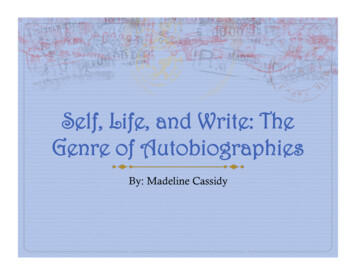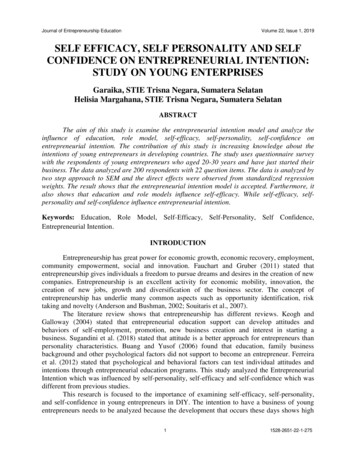
Transcription
Self, Life, and Write: TheGenre of AutobiographiesBy: Madeline Cassidy
What are Autobiographies?Derived from three Greek words “self” “life” and “write”,autobiographies are narratives of the past of aperson by the person concerned. Some literallycritics believes this definition is too broad, and morenarrowly defines the genre as “a retrospective prosenarrative produced by a real person concerning hisown existence, focusing on his individual life, inparticular on the development of his personality.”
Characteristics of an autobiography Characteristics of anautobiography uses “I” “we”“us” Person tells you what theyremember of an event May include flashbacks Used in first person point ofview Story of persons life told bythat person Even the most accuratehave fictional elements Based on truthful lifeexperiences Typically discusses a person’sfailures, hardships, problemsituation, and personal needs Exceptional experiences suchas mystical, physic, and deathrelated experiences are usuallyleft-out
Fun Facts Have been written since 400 A.D Uses 3 main styles of writing: Narrative Descriptive Emotionalfocuses on FOUR major things: who you are in life what life means to you what major life events or criticalissues have had an impact onyour life what your outlook on thefuture is
Why write an autobiography? To leave a message to futuregenerations To pass on your heritage To put closure to a period orepisode To process experiences To preserve family history To share what an who you are
Why should educators incorporateautobiographies into their classrooms? Autobiographies frequently serve as role models byillustrating how even prominent and successful peopleexperience their own triumphs, failures and hardships Many autobiographies promotes diversity and representa broad span of socioeconomic levels Autobiographies constrict meaning and develop an indepth understanding of the life of a prominent person
Classroom AutobiographiesThe most effective autobiographiesto keep in a classroom shouldfocus on three criteria: Are written by authors ofmerit Detail significant people whodisplay gifted behaviors andwhose traits are well-developedby the author include thought-provokingproblem situations, issues, orpersonal needs with whichstudents can identify
Activities teachers can used to integrateautobiographies into lesson plansMobile or DioramaDevelop a mobile, museum display, or dioramarevealing significant information about a person.Life CubeDesign a cube depicting the six most importantevents or people in a person's life.Life NewspaperCreate a newspaper revealing significantinformation about a person. Apply as many ofthe different sections of the paper as possible tothis person's life. What would the want ads forthis person contain? What is the person's sportspage?3-D Time LineMake a paper chain as a three-dimensional timeline that sequences the important events in aperson's life.People BagsCreate "People Bags" by placing in a paper sacksix to ten items that represent the person or theperson's life. Challenge other students to analyzethe contents and figure out the identity of thesignificant person.
Integration into the classroomStudent AutobiographiesAfter reading biographies andautobiographies, students analyze anddiscuss common elements and attributesof this genre. They use this insight tocreate their own autobiographies.My LifeStudents choose one of the activitiesdiscussed earlier in the article to completefor their own lives. To increasecomplexity, encourage them to includeactual past and present events as theypredict future experiences.Meeting of LivesStudents incorporate themselves into thesignificant person's life. Where does this"meeting of lives" occur and how does thestudent's presence affect the event?
CAUTION When picking autobiographies for a classroom make sure youfocus on the content of the story. Since the stories are writtenon real-life accounts, you must review the stories and makesure they are not too tragic or upsetting for the reader The book must be appropriate for the age of the reader Want to make sure the book is an accurate account of theperson’s life Need to carefully analyze what is fiction and what is real withinthe story
Notable authors and illustratorsAnne FrankMaya AngelouDave PelzerNelson MandelaBenjamin FranklinElie WieselAlex HaleyHelen Keller
The ClassicsAlso the 5 books I’ve read and recommend
Excerpt:The Diary of a Young GirlBy: Anne FrankJune 12, 1942”I hope I will be able to confideeverything to you, as I have never beenable to confide in anyone, and I hopeyou will be a great source of comfortand support.Comment added by Anneon September 28, 1942:So far you trulyhave been a great source of comfort tome, and so has Kitty, whom I now writeto regularly. This way of keeping adiary is much nicer, and now I canhardly wait for those moments whenI'm able to write in you.Oh, I'm so gladI brought you along!”
A Child Called ItBy: Dave Pelzer“This book chronicles theunforgettable account of one ofthe most severe child abusecases in California history. It isthe story of Dave Pelzer, who wasbrutally beaten and starved by hisemotionally unstable, alcoholicmother: a mother who playedtortuous, unpredictable games-games that left him nearly dead.He had to learn how to play hismother's games in order tosurvive because she no longerconsidered him a son, but aslave; and no longer a boy, but an"it."
Long Walk to FreedomBy: Nelson Mandela“No one is born hating anotherperson because of the colorof his skin, or hisbackground, or his religion.People must learn to hate,and if they can learn tohate, they can be taught tolove, for love comes morenaturally to the humanheart than its opposite.”
KnuckleheadBy: Jon Scieszka“How did Jon Scieszka get so funny,anyway? Growing up as one of sixbrothers was a good start, but thatwas just the beginning. Throw inCatholic school, lots of comic books,lazy summers at the lake with timeto kill, babysitting misadventures, TVshows, jokes told at family dinner,and the result is Knucklehead. Partmemoir, part scrapbook, thishilarious trip down memory laneprovides a unique glimpse into theformation of a creative mind and afree spirit”
Watch a clip from Knucklehead
The Story of My LifeBy: Helen KellerThe Story of My Life, firstpublished in 1903, isHelen Keller'sautobiography detailingher early life, especiallyher experiences withAnne Sullivan
More books I’ve read and recommend
Sources The Genre of Autobiography: Definition and Characteristics: Basics of an autobiography. 6 May hy Genre Characteristics Chart. 2005. http://www.ux1.eiu.edu/ cfder/GenreCharacteristicsChart.pdf Autobiography. http://www.smccd.edu/accounts/saterfield/Psyc100 03/autobiograhy.html Barton, Fred (2000) "Making a Place: Autobiography in Composition Classrooms," Language Arts Journalof Michigan: Vol. 16: Iss. 1, Article 8. http://dx.doi.org/10.9707/2168-149X.1365 Kingore, B. (Spring 2001). Biographies and autobiographies: Life models in the classroom.Understanding OurGifted, 13 (3), 13-15. http://www.bertiekingore.com/biographies.htm Pelzer, Dave. A Child Called It. Deerfield Beach: Health Communications, Inc., 1995. Frank, Anne. Anne Frank: the Diary of a Young Girl. Trans. B.M. Mooyaart. New York: Bantam, 1993. Nelson Mandela, Long Walk to Freedom: The Autobiography of Nelson Mandela (Boston: Little, Brownand Company, 1995) 230. Scieszka, Jon. Knucklehead: Tall Tales & Mostly True Stories about Growing up Scieszka. New York, NY: Viking,2008. Print.
Sources Pettinger, Tejvan. "Biography of Helen Keller", Oxford, www.biographyonline.net - 5th Feb. 2013. The Story of My Life. Parts I & II by Helen Keller (1880-1968); Part III from the letters and reports of AnneMansfield Sullivan (ca.1867-1936); Edited by John Albert Macy. New York: Doubleday, Page & Company,1905 All short summaries came from: (The diary of a young girl, A child called it, long walk to freedom,Knucklehead, Helen Keller) The New York Times. Sunday book reviews. 2014. http://www.nytimes.com/pages/books/review/
The Story of My Life By: Helen Keller The Story of My Life, first published in 1903, is Helen Keller's autobiography detailing her early life, especially her experiences with Ann











